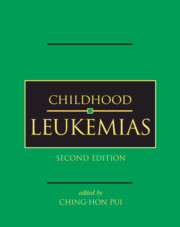Book contents
- Frontmatter
- Contents
- List of contributors
- Preface
- Part I History and general issues
- Part II Cell biology and pathobiology
- 4 Anatomy and physiology of hematopoiesis
- 5 Hematopoietic growth factors
- 6 Signal transduction in the regulation of hematopoiesis
- 7 Immunophenotyping
- 8 Immunoglobulin and T-cell receptor gene rearrangements
- 9 Cytogenetics of acute leukemias
- 10 Molecular genetics of acute lymphoblastic leukemia
- 11 Molecular genetics of acute myeloid leukemia
- 12 Apoptosis and chemoresistance
- 13 Heritable predispositions to childhood hematologic malignancies
- Part III Evaluation and treatment
- Part IV Complications and supportive care
- Index
- Plate Section between pages 400 and 401
- References
4 - Anatomy and physiology of hematopoiesis
from Part II - Cell biology and pathobiology
Published online by Cambridge University Press: 01 July 2010
- Frontmatter
- Contents
- List of contributors
- Preface
- Part I History and general issues
- Part II Cell biology and pathobiology
- 4 Anatomy and physiology of hematopoiesis
- 5 Hematopoietic growth factors
- 6 Signal transduction in the regulation of hematopoiesis
- 7 Immunophenotyping
- 8 Immunoglobulin and T-cell receptor gene rearrangements
- 9 Cytogenetics of acute leukemias
- 10 Molecular genetics of acute lymphoblastic leukemia
- 11 Molecular genetics of acute myeloid leukemia
- 12 Apoptosis and chemoresistance
- 13 Heritable predispositions to childhood hematologic malignancies
- Part III Evaluation and treatment
- Part IV Complications and supportive care
- Index
- Plate Section between pages 400 and 401
- References
Summary
Introduction
Hematopoiesis refers to all aspects of the process of blood cell production. Understanding this process requires a comprehensive knowledge of both the anatomy and the physiology of the blood-forming system. Here, the anatomy of the hematopoietic system is viewed as the distinguishable stages of differentiation that together make up the complete hierarchy of hematopoietic cells. These stages reflect the changes that initially endow cells in the embryo with hematopoietic differentiation potential (a step referred to as specification), in addition to those that subsequently constitute the processes of lineage restriction and terminal differentiation. The physiology of hematopoiesis refers to the dynamic aspects of these events and covers issues such as the determination of alternate outcomes, at both the cellular and molecular level, as well as their modulation during development and in response to injury or disease.
Leukemias arise from clonal accumulations of mutations that impact the production and differentiation of blood cells. Because of the low probability of such events, a large number of divisions is thought to be required for their successive acquisition. It is therefore not surprising that, in many leukemias, the first leukemogenic mutation appears to take place in a hematopoietic stem cell. Moreover, in spite of the acute picture of many leukemias, there is growing evidence that they may result from relatively subtle perturbations of the mechanisms that regulate normal hematopoiesis. A framework for understanding normal hematopoiesis is therefore essential to obtaining new insights into the nature and better management of these diseases.
- Type
- Chapter
- Information
- Childhood Leukemias , pp. 69 - 105Publisher: Cambridge University PressPrint publication year: 2006
References
- 4
- Cited by

